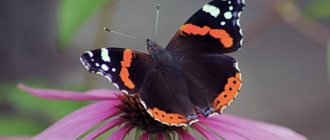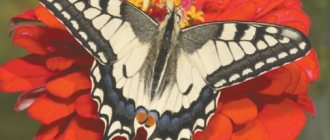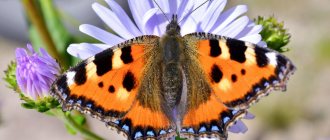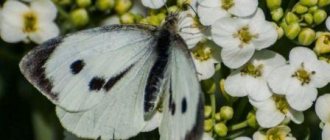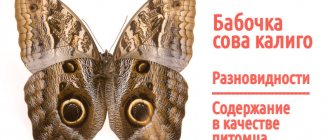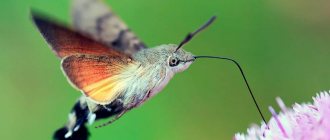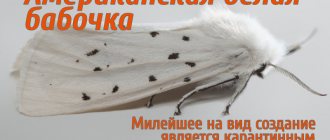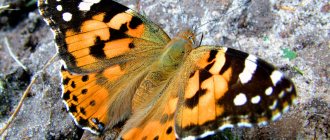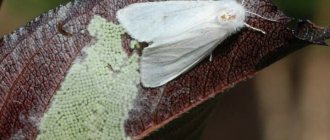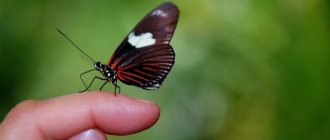A large diurnal butterfly from the nymphalidae family is found throughout the Palearctic. Its Russian name "mourning" is associated with the dark color of the wings. In America it is known as the "mourning robe". The butterfly appears in clearings, meadows and gardens with the first warm months of spring. She winters in reliable shelters, and when the sun warms up, she flies out to feed and procreate. The mourning butterfly is a real long-liver; the adult dies at the age of 11-12 months.
Appearance
Hide Announcement: Habitat Reproduction Duration and lifestyle Enemies and Interesting facts Flight time, Nutrition, Number
Butterfly larvae are black, with small white and large red spots. The insect itself is dark brown. Her wings have a large yellow border and small blue and blue spots. The size of the front wing reaches 40 millimeters, and the wingspan reaches 90 millimeters.
Features of character and lifestyle
Photo: Daytime mourning butterfly
With the onset of spring, butterflies emerge from secluded places, bask in the sun and look for food for themselves. In Russia they can be found only from July-August to October. When the nights become cool, insects begin to look for places to winter - cracks in stumps and trunks to protect themselves from the cold, basements of residential buildings.
The dark color of the wings helps insects easily hide in the grass. At the beginning of spring, only females can be found. They lay eggs and then die immediately. These individuals are capable of covering vast distances. Migration usually occurs in the fall in search of refuge.
Interesting fact: You can determine the cardinal directions by the mourning table. When a moth sits down to rest, it folds its wings and turns its back to the sun. In the morning the wings are turned to the east, at noon to the south, and in the evening they point to the west.
Mourning women appear in one generation. The subspecies have not been studied, but there are a lot of them. The brightness of their color depends on the time of year and habitat. When emerging from the cocoon in the spring, the insect will have a duller color. Immediately after birth they migrate. In hot weather, flights take several days. They depend on weather conditions.
Moths can live until June of next year, and in the mountains until August. In spring, butterflies live in places far from where they were born. In winter, many cannot withstand the frost and die. From the beginning of summer, the number of males predominates, then the inequality is eliminated.
Reproduction
The queen of the Amazons breeds once a year, but more than 100 eggs can be found in a clutch. Female insects attract males thanks to pheromones located in the back of the abdomen. The mating process for a butterfly is long and can last from 20 minutes to several hours.
Mating occurs in the places where they live. Caterpillars grow in the first 2 months of summer. Future arthropods have the same color as the larvae. The caterpillars mainly feed on birch, maple, ash, and rose trees.
What does the mourning butterfly eat?
Photo: Mourning Butterfly
Insects prefer overripe fruits - mainly plums and apples - to flower nectar. Moths are very attracted to the smell of sweet and sour fermentation. Clusters of these creatures can be found on damaged tree trunks on which tree sap has appeared. Butterflies especially like birch sap.
Having drunk the fermented juice, the moths become absent-minded and lose vigilance, so they become prey for birds and small rodents. Mourningbirds sit on flowers and field weeds. Creatures cannot obtain the lack of vitamins and microelements from pollen, so they make up for it from rotting carrion and animal excrement.
It is very important for moths to receive a sufficient amount of moisture, so it is vital for them to live near bodies of water. At the caterpillar stage, insects feed on food plants.
Their diet includes:
- hawthorn;
- rose hip;
- maple;
- Linden;
- alder;
- willow;
- poplar;
- nettle.
Often beautiful creatures can be found sitting on the ground near fruit-bearing trees, trying to feast on overripe fruits. They often choose cracked fruits so that they can easily extract the juice. Caterpillars spend most of their time searching for food. Before hibernating, they feed heavily, trying to eat as much vegetation as possible.
Experiments (stories of one boy)
One day I was wandering through the forest and came across an overgrown pond. Around this swamp I saw a mourning butterfly. I don’t know how, but in the thick of the grass I noticed a small cocoon, which I eventually brought home.
Having found a glass jar, I immediately made a dozen holes in it and put the cocoon I found in the forest there. A few weeks later, a winged insect hatched from this cocoon. Just as beautiful as those that were near that swamp. It was at this moment in my life that I saw how metamorphoses occur in nature.
Where does the mourning butterfly live?
Photo: Mourning butterfly from the Red Book
The species is widespread in the Palearctic. Moths are accustomed to life in temperate climates. Therefore, they cannot be found in tropical areas. Insects do not go further than 68 degrees north latitude. Mourning birds live in England, Norway, and Germany. Migrating individuals have been observed on the shores of the Arctic Ocean.
The species is distributed in Japan, throughout Europe and Asia, North America, and northern Africa. Does not appear in Greece, southern Spain and on the shores of the Mediterranean Sea. Inhabits the Caucasus and Carpathian mountains, with the exception of the Black Sea coast. The species is absent on the Crimean Peninsula, but vagrant individuals can be found.
The insects were artificially brought to North America, and from there the butterflies spread from Mexico to Canada. Previously, the species lived throughout Europe, but after the end of World War II, their numbers declined sharply. In the tundra zone only migrating individuals are found, in forest-steppe and steppe areas - only in forest valleys.
With the onset of warm spring days, moths circle in clearings, gardens and meadows, the banks of reservoirs, and roadsides. For wintering, they look for reliable shelters, and when it gets warmer, they go outside to search for food and reproduce. They can be found at altitudes of up to 2000 m. Life expectancy under favorable conditions is up to one year.
Habitat
Individuals of the Willow Moth are found in the Central and Eastern parts of Europe, in Central and Southern Russia, in the northwestern region of Kazakhstan, in most of China, and throughout the Amur region. Many individuals live in Japan, Korea and Primorye.
In Russia, you can most often find the Perelivnitsa:
- Southern Urals;
- Western Siberia;
- Eastern Transbaikalia;
- area near the Carpathian Mountains;
- Middle Volga region.
Likes to settle in forests of all types, near water bodies. Some subspecies live at an altitude of 1500 meters above sea level in the Carpathian Mountains. The main condition for living is high humidity. It is needed for the full development and growth of caterpillars. In hot and sunny weather, large concentrations of butterflies are observed near rivers and lakes.
Interesting Facts
During flight, the butterfly can reach speeds of up to 60 km/h; the fastest of them are representatives of the hawk moth family.
Attacus Atlas is considered the largest of the Lepidoptera; it is sometimes mistaken for a representative of the avian species. The width of its wingspan is 30 cm. And the smallest is Stigmellaridiculosa, living on the Canary Islands, its wings spread only 2 mm.
They are the second most important pollinator after bees.
The names of butterflies contain names from ancient Greek mythology. They are believed to be as beautiful as mythological heroes.
It has been proven that daytime beauties appeared about 40 million years ago, and nighttime beauties are even older - their representatives lived on earth already 250 million years ago.
There are clinics that provide treatment for stress by observing these insects. And there are countries where they are considered a delicacy.
In the modern world, greenhouses are gaining popularity, where you can admire these moths of divine beauty. And some hobbyists grow them at home.
House butterflies are not particularly problematic to keep. The main thing is not to harm the insect and know what to feed it. For starters, you can try getting caterpillars.
These beautiful creatures can be both beneficial and pests. The gluttony of the caterpillars leads to damage to the harvest on fruit trees, and adult individuals help pollinate them and increase the yield. In their developmental stages, they serve as food for birds and help produce the finest silk fabrics.
Lepidopteran beauties are an adornment of nature - this is proven by numerous photos of butterflies. It is impossible to imagine a sunny summer day in a meadow without the fluttering colors of these moths.
Particularly beautiful are daytime individuals, distributed throughout the globe except Antarctica. They live wherever flowers can be found.
Life cycle
After wintering, adults appear in April (sometimes March) and fly until mid-May. Insects with complete transformation go through 4 successive phases in life:
- egg;
- larva;
- chrysalis;
- imago.
By the end of May, mourning birds have time to mate and lay eggs, from which larvae emerge 3 weeks later. Small caterpillars form colonies on leaves, entwining them with silken webs. Larval development occurs in 5 stages or instars. Their change is characterized by molting - shedding and eating the old skin. With each age, the caterpillar becomes larger. In early July, the larvae pupate.
After 2 weeks, young individuals of a new generation emerge from the pupae. Having barely grown stronger, after 3-5 days they enter diapause. This state of rest and slowing down of life processes continues until the end of August. When butterflies wake up, they begin to actively feed in order to store enough energy for a long winter sleep. The favorite food of insects is rotten fruits, which, after ripening, fall to the ground in large quantities. The diet includes plums, pears, peaches, and apples. The butterfly enters a state of suspended animation with the onset of autumn. The mourner hides under the bark of trees, the forest floor, and seeks shelter in the cracks of outbuildings and in attics. What does a mourning butterfly look like in winter? It folds its wings behind its back and turns into a thin brown leaf. During wintering, some insects are eaten by natural enemies - birds and rodents. The life cycle of the mourning butterfly is 1 year.
What are the main characteristics
The insect belongs to the nymphalidae family. In Latin – Nymphalisantiopa (Nymphalis antiopa). This is the second name of the insect, associated with Antiope - the queen of the Amazons from Greek mythology. The mourner is very beautiful, that’s why she was nicknamed that way.
The insect is large in size, the wingspan can reach 7–9 cm, and the length of the front wings can be from 3 to 4.5 cm. The individual only has a gloomy name, but she herself is very beautiful. In the photo you can see that the insect’s upper wings are dark brown. Along the winding edge there is a wide white stripe, from which small blue spots extend. The lower wings are black. The appearance of the butterfly (color) does not depend on gender; it is the same in females and males.
The insect's body is oval-shaped and has a brownish color that is close to black. There are long antennae on the head, and thin legs under the abdomen.
A similar sign
It happens that winged guests appear in our house. For them, this is an unusual, even frightening, incident. For us, this is also an incident, but not as significant. People who know how to listen to the Universe, feel and see its signs, understand that the appearance of a butterfly is not accidental. What can you think about if a butterfly flies into the house? This sign is old and is passed down from generation to generation.
Folk sign: a butterfly flew into the house
It is thanks to its beauty that the butterfly received the title of the messenger of good luck, wealth and prosperity. Well, how can something bad happen when such beauty flies into the house? After all, nothing terrible can even come to mind. And then the conclusion about the positive nature of the flying butterfly was made after statistics showed a series of pleasant events in the home of those who were visited by a wonderful guest.
Many ancients believed that a beautiful, pure soul was hidden in a butterfly. And Buddha, for example, even preached to a butterfly at one time. After all, its flight is simply mesmerizing, it is impossible to take your eyes off the butterfly, because it charges you with its energy, because it once hatched from a cocoon, which symbolizes a constant series of rebirths, akin to the human soul. It is a pity that the life of a butterfly is short-lived.
If a butterfly flies into your window, rejoice. Something very good is coming your way soon. For example, easy childbirth, pregnancy, luck. It all depends on what you are currently expecting.
The butterfly must be caught very carefully
Try to very carefully catch the butterfly when it flies into your house. Under no circumstances should its wings be damaged. You need to whisper your dream to the alien and let her go so that she can tell the heavenly office about your desire.
Be sure that everything will certainly come true for you. A butterfly dancing in the house brings a quick wedding. If the guest calmly sat down on some surface, a wonderful rest and meeting with old friends awaits you. If a butterfly flew into your door, guests will soon come to your house, whom you will be very pleased to meet.
If the guest who flew in is golden, yellow or green, you will experience good luck and prosperity in the near future. Red (and also pink) - expect good luck in your personal life. If the flying insect has dull wings, then luck will not stay with you for long. The wings are bright (and the brighter the better) - great success is guaranteed.
Watch the video
How to use Runes correctly
A book for beginners in Tarot
Sign up and receive a gift!
Why, according to legend, did a butterfly fly onto the balcony?
Insects often fly onto the balcony, especially if it is not glazed. This is not housing, but many signs interpret such guests positively. It is no coincidence that many people plant flowers on their balconies to attract insects. There are several interpretations of this situation:
- this is news about the arrival of a new tenant: a child will be born or someone from the family will meet their soul mate;
- a person will have fun, travel, meet friends;
- It is believed that these insects protect the house from troubles and misfortunes.
If there is a chocolate butterfly in the house
If the flying guest is a chocolate lover, then you should expect from her the same as from a black butterfly, i.e. nothing good. Well, unless she's dancing in the air...
Natural enemies of mourning butterflies
Photo: Mourning butterfly from the Beautiful Book
At all stages of development, the insect is surrounded by many enemies. Spiders, beetles or ants are not averse to eating moth eggs. Adults are affected by some species of birds, reptiles or small rodents. Although Lepidoptera have a camouflage color that turns them into a dried leaf, many individuals do not survive until spring, being discovered in shelters.
Caterpillars suffer from parasitic insects, Hymenoptera, which lay eggs directly in their bodies. Pests also lay eggs on food plants. Caterpillars eat leaves with clutches and parasitoids develop in the body of future butterflies, eating them from the inside. Riders are born already fully formed.
Parasites include ovoid, larval, ovolarval, pupal, and larval-pupal types. Some of them can paralyze the victim completely or certain parts of their body. Organisms live and develop at the expense of butterflies. As a result of their vital activity, lepidoptera die or become sterile.
Spiders and mantises hunt moths from ambush. They wait for beautiful creatures on flowers or catch them in their webs. Enemies include some species of wasps and ground beetles. Blackbirds and dragonflies hunt for mourning birds during flight. Toads and lizards lie in wait for butterflies on the ground and near water bodies.
Interesting Facts
- Males have scales on their forewings that emit odorous gases to attract females.
- The purple or metallic sheen on the wings of males is not the result of pigmentation. You can see this beautiful effect only in sunny weather and from a specific angle. The bright iridescence helps males to deceive their enemies and hide from them.
- The caterpillar overwinters on willow bark. During this period, the body color acquires a brown tint, thanks to which the insect is well camouflaged. As soon as spring arrives and the weather warms up, the caterpillar again acquires a light green color.
- When butterfly hunting became popular, collectors used dung and carrion to attract butterflies. Before this, they used huge nets with a handle 9 meters long.
- The name "Iris" comes from Greek mythology. She was considered the goddess of the rainbow and was a mediator between humanity and the deities.
- The Splinter has poorly developed front legs. They are pressed to the body and have no functions.
- A butterfly may fly to a shiny thing because it is attracted to bright objects.
- There are special receptors on the antennae that detect odorous signals in the air.
- In 2011, the species Willow Moth was declared the butterfly of the year in Germany.
NOT MOURNING AT ALL
The Russian name for the mourning table speaks for itself. And among many other peoples, the dark color of its wings is associated with mournful clothing. The English call this butterfly “mourning mantle”, the Poles call it “gardener-complainer”, and its French name means “mourning, grief, sadness”
The underside of the wings of this butterfly is also “velvet”, but is more modestly colored - dark with unclear streaks.
However, in reality, Antiope does not look gloomy at all. Yellow or white fringe and a row of lilac ovals along it make the butterfly very elegant. And the color of its wings is more likely cherry or violet-brown than black. They are covered with thick hairs, thanks to which they appear velvety and, with appropriate lighting from a distance, appear black. Males and females look almost the same, but the differences in the color of butterflies from different climatic zones are quite noticeable.
Popular message topics
- Magnet
Magnets are bodies that have their own field. The simplest magnet is the electron. A magnet has 2 poles + and -. Magnets will attract each other if they are of different poles. If they have the same poles, - White hare
The largest species from the order of lagomorphs is the white hare. The weight of this species is up to 5 kg, and the body length can reach up to 65 cm. The tail is round, with a diameter of up to 8 cm. Ears are up to 10 cm. Males are always smaller than females. hairs, - Wonderworker Nicholas
New Year is a time of miracles, fairy tales and gifts. Most people on the planet celebrate this holiday and look forward to its arrival. But there is another holiday that is more joyful for children than for adults - this is St. Nicholas Day.
Lemongrass buckthorn
This species is also called buckthorn, or common lemongrass. The butterfly is the most typical and widespread representative of its genus. Males are colored an even light yellow, females are pale green. There is one orange dot on the front and rear wings.
Common lemongrass can be seen in sunny forest clearings and meadows. They do not like dense thickets of trees and do not rise above 2 kilometers in the mountains. They are rare guests in deserts and steppes. They live in Eastern Europe, North Africa, and Central Asia. They are found in the Caucasus, Mongolia, Turkey, and the western and southern regions of Siberia.
TEMPERATURE FORMS
The mourning dress has one interesting feature. The color of butterfly wings depends on the refractive abilities of the scales covering the wing and the distribution of pigments in them. In some species, the deposition of pigments is influenced by the temperature conditions in which the pupa was located. This has been well studied using the example of a mourning bowl. When the pupa is exposed to low temperatures, the general background of the wing darkens, the blue spots decrease, and the dark pigment melanin is deposited throughout the yellow border in the form of a black dotted coating. Interestingly, similar changes occur at high temperatures, about 35-37 °C. This determines the differences in the color of individuals living in different climatic conditions.
